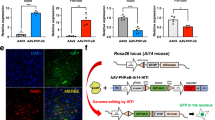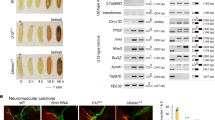Abstract
Spinal muscular atrophy (SMA) is a common autosomal recessive neuromuscular disease in children caused by homozygous deletion of the survival motor neuron 1 gene (SMN1). Plastin 3 (PLS3) has been identified as a protective modifier of SMA. We analyzed the levels of PLS3 expression in peripheral blood from 65 children with SMA and 59 healthy controls by using real-time PCR. In healthy controls, younger children (⩽3 years) showed >1.75-fold higher levels of PLS3 expression than did older child cohorts (∼3–6 years, ∼6–12 years and >12 years). In the older female subjects with SMA (>3 years), PLS3 expression was 56.7% lower in type II subjects than in type III patients (P=0.011). When these female subjects carried three copies of SMN2, PLS3 expression was 62.6% lower in the type II subjects than in type III subjects (P=0.008). Moreover, there was a trend toward higher PLS3 expression in older female patients who could walk unaided (>3 years and SMN2 copy number=3) than those who could not. However, these differences were not observed in male subjects examined by SMA clinical type and SMN2 copy number (P>0.05). We concluded that the PLS3 gene may have an age- and gender-specific role in the clinical severity of SMA in children afflicted with this condition.
Similar content being viewed by others
Log in or create a free account to read this content
Gain free access to this article, as well as selected content from this journal and more on nature.com
or
References
Alías, L., Bernal, S., Fuentes-Prior, P., Barceló, M. J., Also, E., Martínez-Hernández, R. et al. Mutation update of spinal muscular atrophy in Spain: molecular characterization of 745 unrelated patients and identification of four novel mutations in the SMN1 gene. Hum. Genet. 125, 29–39 (2009).
Prior, T. W., Swoboda, K. J., Scott, H. D. & Hejmanowski, A. Q. Homozygous SMN1 deletions in unaffected family members and modification of the phenotype by SMN2. Am. J. Med. Genet. A. 130, 307–310 (2004).
Prior, T. W., Krainer, A. R., Hua, Y., Swoboda, K. J., Snyder, P. C., Bridgeman, S. J. et al. A positive modifier of spinal muscular atrophy in the SMN2 gene. Am. J. Hum. Genet. 85, 408–413 (2009).
Oprea, G. E., Kröber, S., McWhorter, M. L., Rossoll, W., Müller, S., Krawczak, M. et al. Plastin 3 is a protective modifier of autosomal recessive spinal muscular atrophy. Science 320, 524–527 (2008).
Stratigopoulos, G., Lanzano, P., Deng, L., Guo, J., Kaufmann, P., Darras, B. et al. Association of plastin 3 expression with disease severity in spinal muscular atrophy only in postpubertal females. Arch. Neurol. 67, 1252–1256 (2010).
Hao le, T., Wolman, M., Granato, M. & Beattie, C. E. Survival motor neuron affects plastin 3 protein levels leading to motor defects. J. Neurosci. 32, 5074–5084 (2012).
Ackermann, B., Kröber, S., Torres-Benito, L., Borgmann, A., Peters, M., Hosseini Barkooie, S. M. et al. Plastin 3 ameliorates spinal muscular atrophy via delayed axon pruning and improves neuromuscular junction functionality. Hum. Mol. Genet. 22, 1328–1347 (2013).
Ahmad, S., Wang, Y., Shaik, G. M., Burghes, A. H. & Gangwani, L. The zinc finger protein ZPR1 is a potential modifier of spinal muscular atrophy. Hum. Mol. Genet. 21, 2745–2758 (2012).
Hauke, J., Riessland, M., Lunke, S., Eyüpoglu, I. Y., Blümcke, I., El-Osta, A. et al. Survival motor neuron gene 2 silencing by DNA methylation correlates with spinal muscular atrophy disease severity and can be bypassed by histone deacetylase inhibition. Hum. Mol. Genet. 18, 304–317 (2009).
Acknowledgements
This study was supported by National Natural Science Foundation of China (81050034) and Research Foundation of Capital Institute of Pediatrics (CIP2013-01). We would like to thank the patient and his parents for their collaboration in this investigation. We would also like to thank Editage for providing editorial assistance.
Author information
Authors and Affiliations
Corresponding author
Rights and permissions
About this article
Cite this article
Yanyan, C., Yujin, Q., Jinli, B. et al. Correlation of PLS3 expression with disease severity in children with spinal muscular atrophy. J Hum Genet 59, 24–27 (2014). https://doi.org/10.1038/jhg.2013.111
Received:
Revised:
Accepted:
Published:
Issue date:
DOI: https://doi.org/10.1038/jhg.2013.111
Keywords
This article is cited by
-
Management and current status of spinal muscular atrophy: a retrospective multicentre claims database analysis
Orphanet Journal of Rare Diseases (2020)
-
A rare variant (c.863G>T) in exon 7 of SMN1 disrupts mRNA splicing and is responsible for spinal muscular atrophy
European Journal of Human Genetics (2016)
-
Decay in survival motor neuron and plastin 3 levels during differentiation of iPSC-derived human motor neurons
Scientific Reports (2015)
-
PLS3 expression and SMA phenotype: a commentary on correlation of PLS3 expression with disease severity in children with spinal muscular atrophy
Journal of Human Genetics (2014)



